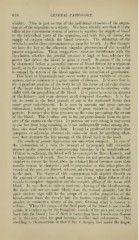Page 668 - My FlipBook
P. 668
678 GENERAL PATHOLOGY.
vitality. This is just as true of the individual elements of the organ-
ism as of the organism as a whole. We have already seen that it is the
office of the vaso-motor system of nerves to regulate the supply of blood
to the individual parts of the organism, and with this, of course, the
supply of oxygen which the blood conveys. The dilatation of the
vessels is, under these circumstances, a gasp for breath. In this thought
we have the key to the otherwise singular phenomena of the so-called
passive congestions. These congestions occur on interference with the
circulation, whether the arterial pressure is high or low, wdiether the
power that drives the blood be great or small. It occurs if the veins
be obstructed before a powerful current of blood driven by a vigorous
heart, or in the presence of a feeble current driven by a heart too weak
to compel the return of the blood against the attraction of gravitation.
This kind of hypersemia may occur under a great variety of circum-
stances, and is common to a great variety of diseases. It is seen first in
the dependent portions of the body in all the forms of valvular disease
of the heart when they have made such progress as to interfere mate-
rially with the propulsion of the blood. It is prone to occur in diseases
of the kidneys, and is an element in all dropsical disorders. It is lia-
ble to occur in the later periods of any of the continued fevers that
cause great enfeeblement. It is seen in ansemia and great nervous
exhaustion ; indeed, in any condition of great reduction of the vital
powers. It occurs also from pressure on the veins preventing the return
of the blood. This is often seen in the pregnant female from the pres-
sure of the uterus on the veins. In persons not very strong it may occur
in the feet from long standing, as is not uiifrequently noted among den-
tists who stand much at the chair. It may be produced by tumors that
compress or otherwise obstruct the veins—in short, by anything what-
ever that obstructs the free passage of the blood back to the heart.
The results of paKsive hypercrmia are somewhat complex. In case of
the obstruction of a vein the amount of hypersemia will obviously
depend on the number of anastomosing branches in the neighborhood.
If these be sufficient, the blood will be conveyed by these channels, and
no hyperemia will result. But in case these are not present in sufficient
number to convey the blood, then the retained blood becomes more than
usually venous in character ; and in proportion as this takes place the
vessels of the ]xirt are dilated, relaxed, admitting more and more blood
to the part. The degree of this engorgement will depend directly on
the amount of obstruction, and may vary from a slight fulness of the
vessels to complete stagnation and the complete fiUing of the tissue vyith
hloofl. In case there is only a moderate slowing of the blood-current,
the tissue will contain more blood than the normal quantity, but the
hiost obvious sign will be the escape of an undue proportion of the
blood-serum from the vessels into the tissues, especially the cellular,
areolar, or connective tissues of the pan, forming what is known as
ce.dema. When this escape of the fluid parts of the blood is not consid-
erable, it is taken u]> by the lymjihatic vessels of the part and conveyed
back into the blood ; but if there is more than these vessels can dis]iose
of in this way, then the part becomes swollen and oedematous. This
swelling is characteristic in that it has a doughy feel under the finger,


